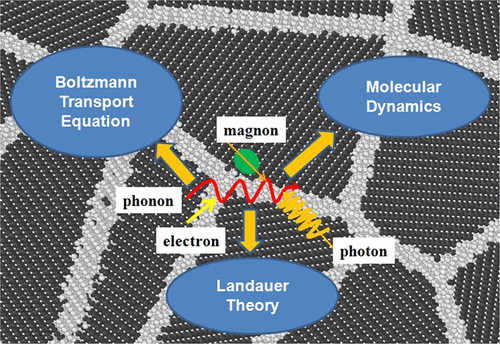Our official English website, www.x-mol.net, welcomes your
feedback! (Note: you will need to create a separate account there.)
Methodology Perspective of Computing Thermal Transport in Low-Dimensional Materials and Nanostructures: The Old and the New
ACS Omega ( IF 3.7 ) Pub Date : 2018-03-19 00:00:00 , DOI: 10.1021/acsomega.7b01594 Yanguang Zhou 1 , Zheyong Fan 2, 3 , Guangzhao Qin 4 , Jia-Yue Yang 4 , Tao Ouyang 5 , Ming Hu 1, 4
ACS Omega ( IF 3.7 ) Pub Date : 2018-03-19 00:00:00 , DOI: 10.1021/acsomega.7b01594 Yanguang Zhou 1 , Zheyong Fan 2, 3 , Guangzhao Qin 4 , Jia-Yue Yang 4 , Tao Ouyang 5 , Ming Hu 1, 4
Affiliation

|
Demands for engineering thermal transport properties are ever increasing for a wide range of modern micro- and nanodevices and materials-based energy technologies. In particular, there is a severe situation due to the rapid progress in the synthesis and processing of materials and devices with structural characteristic length on the nanometer scales, which are comparable or even smaller than the intrinsic length scales (such as mean free path and wavelength) of basic energy carriers (such as phonons, electrons, and photons). Although advanced approaches for controlling the electronic and photonic transport have been proposed in the past decades, progress on controlling lattice vibrations (i.e., the phonons) is still far behind. Gaps between the fundamental understandings of the behavior of the basic energy carriers at small scales and the technological demands still remain, particularly from a computer modeling point of view. Herewith, we give a perspective of the computational approaches for predicting the thermal transport properties of low-dimensional materials and nanostructures, which are mainly sorted into three categories: empirical molecular dynamics, anharmonic lattice dynamics based Boltzmann transport equation, and Landauer theory. The advantage and disadvantage of each method are discussed and some possible solutions are suggested. The discussion is focused on fully and accurately characterizing the mode-level phonon behavior, possible all-order phonon scattering process, and incorporation of realistic nanostructures. Moreover, emerging challenges of phonon coupling effects, such as electron–phonon, phonon–photon, and phonon–magnon coupling, are also discussed. We expect that this perspective will stimulate future research in computer modeling of micro-/nanoscale heat transfer beyond traditional phonons.
中文翻译:

计算低维材料和纳米结构中的热传输的方法学视角:新旧
对于各种现代微米和纳米器件以及基于材料的能源技术,对工程热传输特性的需求不断增加。特别是,由于纳米尺度结构特征长度的材料和器件的合成和加工的快速进展,其结构特征长度与本征长度尺度(如平均自由程和波长)相当甚至更小,情况更加严峻。 )的基本能量载体(例如声子、电子和光子)。尽管过去几十年来已经提出了控制电子和光子传输的先进方法,但控制晶格振动(即声子)的进展仍然远远落后。对小尺度基本能量载体行为的基本理解与技术需求之间仍然存在差距,特别是从计算机建模的角度来看。在此,我们给出了预测低维材料和纳米结构热输运性质的计算方法,主要分为三类:经验分子动力学、基于玻尔兹曼输运方程的非调和晶格动力学和兰道尔理论。讨论了每种方法的优点和缺点,并提出了一些可能的解决方案。讨论的重点是全面、准确地表征模级声子行为、可能的全阶声子散射过程以及现实纳米结构的结合。此外,还讨论了声子耦合效应的新挑战,例如电子-声子、声子-光子和声子-磁振子耦合。我们期望这一观点将刺激未来对传统声子之外的微/纳米级传热的计算机建模的研究。
更新日期:2018-03-19
中文翻译:

计算低维材料和纳米结构中的热传输的方法学视角:新旧
对于各种现代微米和纳米器件以及基于材料的能源技术,对工程热传输特性的需求不断增加。特别是,由于纳米尺度结构特征长度的材料和器件的合成和加工的快速进展,其结构特征长度与本征长度尺度(如平均自由程和波长)相当甚至更小,情况更加严峻。 )的基本能量载体(例如声子、电子和光子)。尽管过去几十年来已经提出了控制电子和光子传输的先进方法,但控制晶格振动(即声子)的进展仍然远远落后。对小尺度基本能量载体行为的基本理解与技术需求之间仍然存在差距,特别是从计算机建模的角度来看。在此,我们给出了预测低维材料和纳米结构热输运性质的计算方法,主要分为三类:经验分子动力学、基于玻尔兹曼输运方程的非调和晶格动力学和兰道尔理论。讨论了每种方法的优点和缺点,并提出了一些可能的解决方案。讨论的重点是全面、准确地表征模级声子行为、可能的全阶声子散射过程以及现实纳米结构的结合。此外,还讨论了声子耦合效应的新挑战,例如电子-声子、声子-光子和声子-磁振子耦合。我们期望这一观点将刺激未来对传统声子之外的微/纳米级传热的计算机建模的研究。











































 京公网安备 11010802027423号
京公网安备 11010802027423号